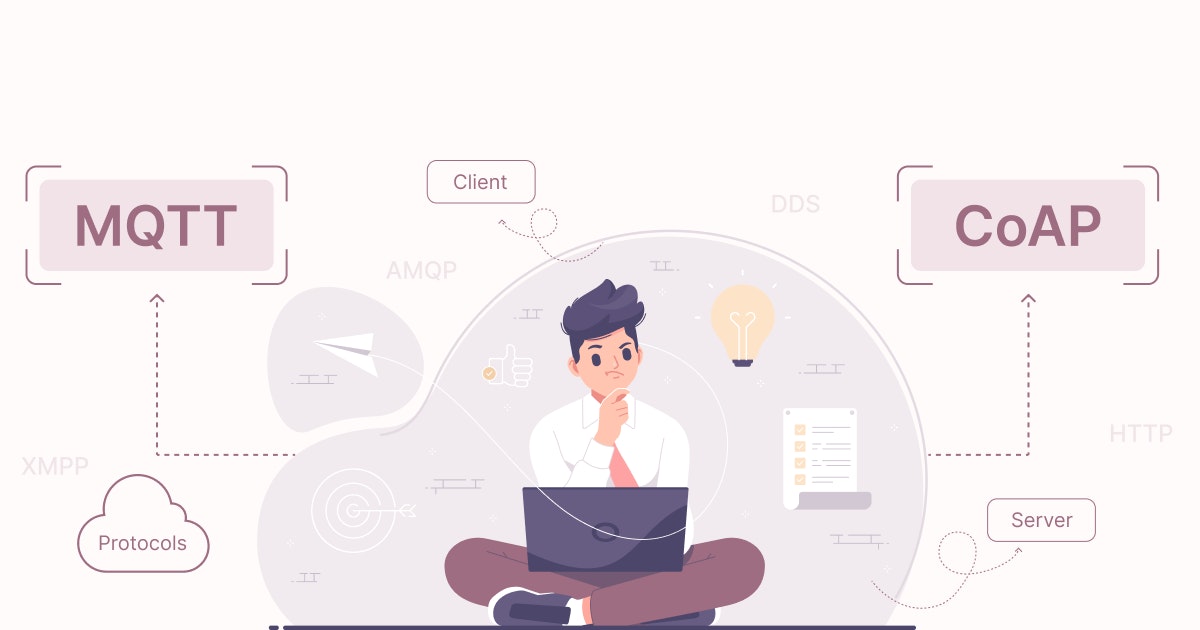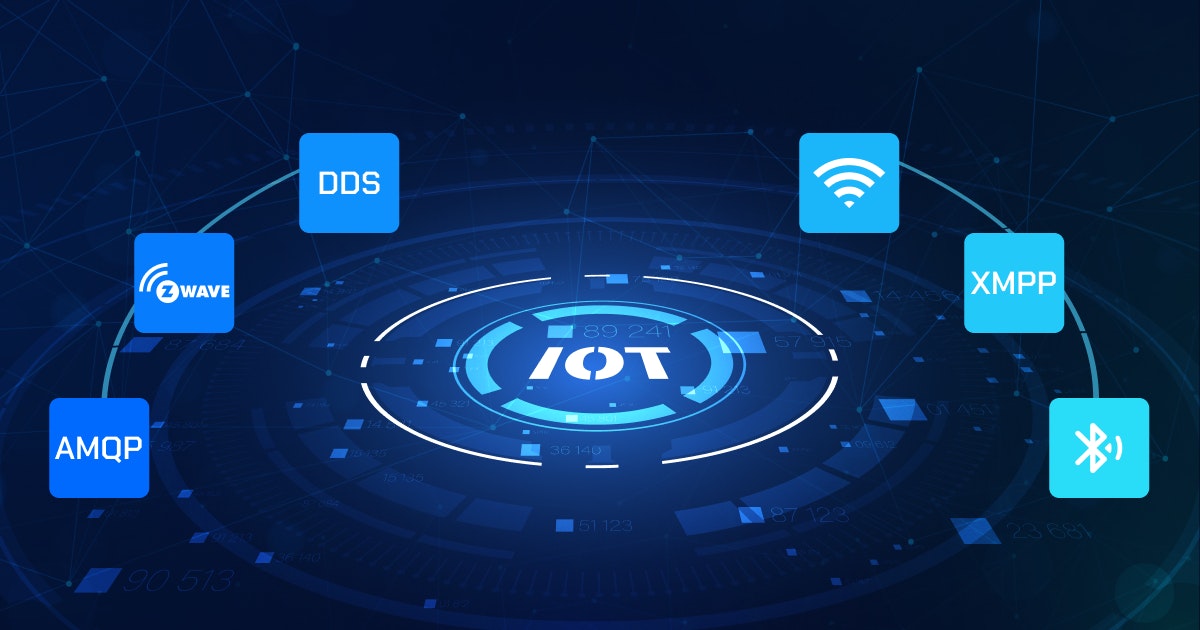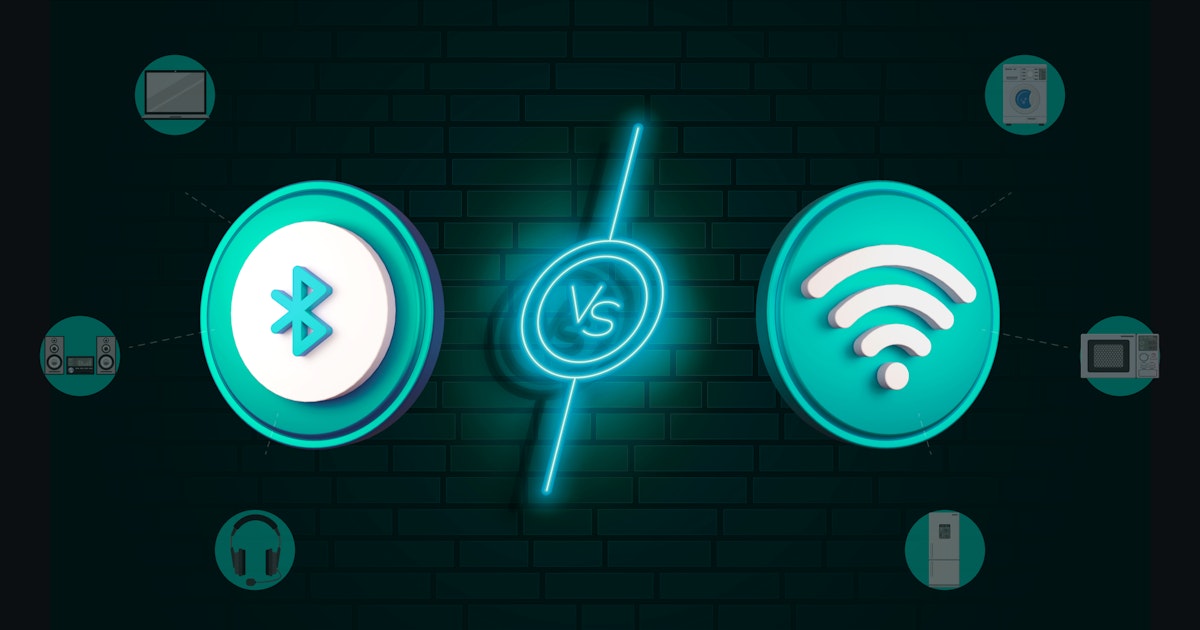Table of Content
IoT protocols are a set of rules that ensure information from one device or sensor gets read and understood by another device, a service, or a gateway. They standardize data sharing, making it safer and more efficient for IoT systems.
They enable the hardware to exchange data properly and in a structured manner. When we think about IoT, we cannot help but think about “communication.” Is that not the whole point of IoT?
Interaction between servers, sensors, gateways, devices, and user apps is what defines IoT! While the programming languages form the foundation of IoT apps, the protocols enable smart communication.
Because of the protocols, the entire implementation process becomes profitable and helpful data can be extracted from the end-user through the transmitted information.
While many IoT protocols exist in the market, MQTT and CoAP stand out for their modularity and scalability. They have rich extensibility and annotation functionalities.
MQTT is a lightweight open messaging protocol offering resource-constrained network clients a simple way to distribute telemetry information in poor-network environments.
CoAP is similar to HTTP and is a document transfer protocol designed specifically for constrained devices. In this article, we will discuss two protocols in-depth and understand the way they work and are deployed, benefits, and use cases:
MQTT
What is MQTT and what does MQTT stand for?
Message Queuing Telemetry Transport or MQTT is a publish-subscribe protocol that enables brokers to mediate one-to-many communication amongst IoT devices. Having said that, clients can publish messages to a broker and/or subscribe to one for receiving specific messages.
MQTT basically transmits messages across devices using a small code footprint and limited network bandwidth. Because of these two advantages, MQTT has carved a niche for itself in various industry verticals, including oil and gas, manufacturing, and automotive.
MQTT was developed in 1999 by IBM and Eurotech for linking sensors on oil pipelines to satellites. Today, MQTT version v5.0 ensures an easy exchange of data within a device network.
Benefits of MQTT
Understanding how an MQTT broker offers ways to aggregate data streams and distribute them securely across a complicated network to ensure the success of IoT projects of any size or nature and keep them consistent. Here are the top benefits of MQTT:
1. MQTT has a simple message encryption message that utilizes TLS and client authentication using modern protocols, such as OAuth.
2. MQTT boasts of a reliable and professional message delivery system, which is why it is much-preferred in many IoT use cases. MQTT also has defined quality of service levels.
3. MQTT clients are lightweight and do not need minimal resources, so they can be utilized on small microcontrollers and optimize network bandwidth with relative ease.
4. The MQTT protocol is easily scalable and can easily connect up to a million IoT devices and sensors.
5. MQTT enables messaging flow from device-to-cloud and cloud-to-device models, simplifying broadcasting messages to a group of IoT devices.
6. MQTT minimizes the issue of unreliable cellular networks over which IoT devices connect. The protocol reduces the time spent reconnecting the client with the broker and supports persistent sessions.
Disadvantages of MQTT
Despite the positives it brings to the table, MQTT might not be ideal in all circumstances. Some of the cons include:
1. Slower transmit cycles compared to CoAP means that MQTT would not work for you if you are looking to manage a system with 250+ devices.
2. There is a lack of security encryption as MQTT uses Transport Layer Security or Secure Sockets Layer (TLS/SSL), which are primarily unencrypted.
3. MQTT runs on a flexible topic subscription system, which is not a stable option for resource discovery.
4. There are higher overheads when it comes to deploying MQTT. Besides, there is no multi-casting MQTT support.
5. Building a globally scalable network is challenging, which is more difficult with an MQTT protocol than other competitors.
Use cases of MQTT
MQTT is one of the most widely-used protocols in IoT and has paved its way in smart homes, processing plants, digital health, and other industry verticals to serve different purposes.
Some popular MQTT-support platforms created for industrial IoT or IIoT include IBM Watson, AWS IoT, ThingWorx, Braincube, and Fogwing. These offer MQTT extension to enable IoT infrastructure connectivity. Let us look at the top six use cases:
1. Wearables
The lightweightness of the MQTT protocol makes it suitable for IoT wearables, which can work with limited internet connection and low power or battery. Data gets published only when it is pushed from the wearable to the server and the receiving devices subscribe to the data pushed. Messages can be transmitted quickly because of the smaller size of the data sets managed by MQTT.
2. Smart farming
The use of smart technology by agri-businesses has the potential to enhance their efficiency and increase overall yield. Smart farming solutions offer consistent monitoring and reporting of weather and soil conditions, such as moisture, pH, air quality, temperature, and so on. MQTT enables IoT sensors to collect data easily even over faulty internet collection.
3. Smart metering
This one takes the cake in the energy and utility sector. Smart meters can collect more detail about energy consumption than traditional meters. An MQTT client can be embedded in the software implemented with the meter, which can be used for transmitting data with the guaranteed message delivery system in real-time. Homeowners can also effectively manage energy consumption and make invoicing/billing more accurate with time.
4. Remote sensing
Sensors used for remote monitoring environments are often low-power solutions functioning from locations or areas with a poor internet connection. MQTT is a wonderful option as it allows communication between devices with lower-priority data transmission requirements.
Architecture of MQTT
In MQTT, the IoT-connected devices are known as clients, which communicate with a server called the “broker,” which handles the task of data transmission and client communication/
Whenever a client wants to publish any information, it does so to a particular topic after which the broker sends the information to any clients subscribed to that topic.
A client can be both a publisher or a subscriber. A broker categorizes the messages into labels before being delivered. It also filters the messages and determines who is subscribed to every message. The sender and receiver of the messages are decoupled.
Implementation of MQTT
An MQTT client can be any device, which runs the MQTT library and connects to the MQTT broker. The former connects to the broker using authentication keys.
The main component of the client is the script used for publishing messages to a topic and then sending them to the broker. Several MQTT client libraries are available for use, depending on your preferred programming language.
As mentioned before, an MQTT broker forms the protocol's core, handling millions of IoT devices. The broker receives, filters, and forwards all messages - depending on the implementation.
CoAP
What is CoAP?
CoAP stands for Constrained Application Protocol. It is a UDP-based binary protocol and has much in common with HTTP. In fact, both protocols work in sync with each other. CoAP supports two forms of communication - request-response and publish-subscribe.
Just like HTTP, it publishes messages to URI and its documentation is available easily. CoAP is also highly scalable and power efficiency and low-memory consumption are its two biggest USPs. CoAP minimizes the message size and overheads.
Benefits and Drawbacks of CoAP
Benefits of CoAP
Unlike MQTT, CoAP is not standardized. It allows a client node to command another node by sending a CoAP packet. The server will then interpret it, decide what to do depending on the logic, and extract the payload. On the other hand, the server does not have to acknowledge the request. There are a few solid advantages to CoAP:
1. Reduced power requirements
CoAP operates over UDP, requiring minimal overheads for enabling communication. The protocol also empowers prompt wake up times and longer sleepy states. This helps achieve longer-lasting battery life for IoT and Machine2Machine or M2M communication.
2. Grass-root-level usage
The CoAP protocol is a brilliant choice for home communication networks. It is helpful for control equipment, communication systems, and information appliances in intelligent home networks.
3. Security
CoAP makes use of DTLS and IPSEC to offer secure communication. It also has lower latency than HTTP, which means it is possible to avoid unnecessary re-transmissions.
4. Prompt
CoAP may not be as reliable as MQTT or HTTP, but it sure is fast. If you are fine with some messages not being received within the IoT ecosystem, you can send many more messages with the same timeframe.
Drawbacks of CoAP
Sure, there are some significant advantages of working with the CoAP protocol. However, is it all hunky dory in this case? Unfortunately, not! Here is a sneak peek into the drawbacks of CoAP:
1. Unreliability
Here is the ultimate CoAP definition: It is an unreliable protocol due to the use of User Datagram Protocol (UDP). Hence, CoAP messages will not reach in the order they are sent in or will get lost when they arrive at the destination.
Therefore, to increase the reliability quotient of CoAP, you must incorporate back-off re-transmission. Duplicate detection is also possible with this feature.
2. Longer processing times
CoAP deals with communication issues for devices functioning behind the Network Address Translation (NAT). It acknowledges each receipt of the message, increasing the processing time.
3. Lousy implementation methods
CoAP is an encrypted protocol that utilizes DTLS for providing security at the cost of implementation overheads. In addition, it does not verify whether the received message has been appropriately decoded or not.
Use cases of CoAP
When it comes to CoAP, one can vouch for its compatibility with HTTP. If you have a web service-based system, adding in CoAP is a fantastic option. It is developed on User Datagram Protocol (UDP) that does an excellent job in resource-constrained environments where devices need to speak with each other promptly.
If an IoT developer works on a device leveraging an existing web server architecture, it is best to use CoAP. If the device being built is for “report only” purposes, which means it only needs to report the data back to a server, CoAP will do wonders.
However, MQTT will definitely be a better option for its live communication and unwavering support for systems operating on cloud architecture.
MQTT vs. AMQP: IoT Protocols You Must Know About
Learn MoreArchitecture of CoAP
CoAP is a client server-based protocol that allows the CoAP packet to be shared between different client nodes commanded by the CoAP server. It is responsible for transferring data depending on its logic but has not acknowledged it.
CoAP is used in apps that support the state transfer model. CoAP supports 1:1 communication, and like MQTT, the protocol requests servers to serve data in a pre-defined format. The servers interpret the request and send data accordingly. CoAP can PUT, DELETE, GET, and POST and offer interoperability with RESTful APIs and HTTP.
Implementation of CoAP
The sensor nodes receive and translate messages coming from the client, which can be any resources needing the sensor information. Several server and client deployments for CoAP available in mainly C and other languages. CoAP has browser and smartphone-based client implementations available.
Difference between MQTT and CoAP
While MQTT is useful for passing messages between multiple clients through a centralized broker, CoAP transfers state information between the client and server.
MQTT offers no support for labeling messages and can be used for any purpose. However, all clients must know the message formats up-front to enable communication.
On the other hand, CoAP offers built-in support for content discovery and negotiation, enabling devices to probe each other for finding ways to exchange data.
Both MQTT and CoAP are excellent protocols. They have many advantages. However, in comparison, you will find how different they are. Let us take a look at their top differences:
Similarities between MQTT and CoAP
Despite the massive differences between the two protocols, MQTT and CoAP are similar in many respects. For starters, they are both open standards and are better to function in unnatural environments than HTTP.
MQTT and CoAP enable asynchronous communication, making it possible for two devices to communicate without being present at the same moment in time and have a defined area for execution.
Therefore, before choosing either of the protocols, it is a must for you to know business requirements, realization of the pros and cons of the protocols, and the capability to choose the one that best suits your requirements.
Over to you
While CoAP’s strongest benefit is its compatibility with HTTP and the fact that it works well with a web-based system. On the other hand, MQTT is known for its reliability, fast response delivery time, and unlimited device support.
MQTT also has a stronger developer community that simplifies protocol deployment. So if you are looking for support in choosing the best IoT protocol, Intuz can help!
Our knowledgeable developers are experienced in working with both protocols and on diverse IoT projects. Share your contact details with us by
filling the contact form and we will get back to you for a consultation at the earliest.





